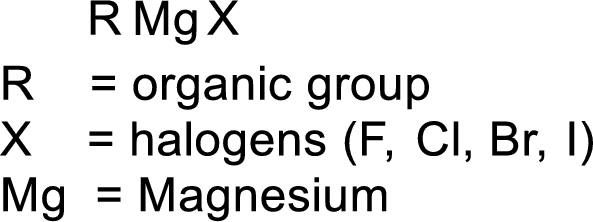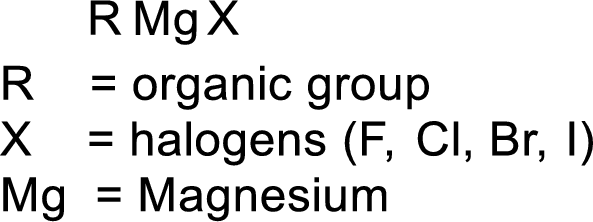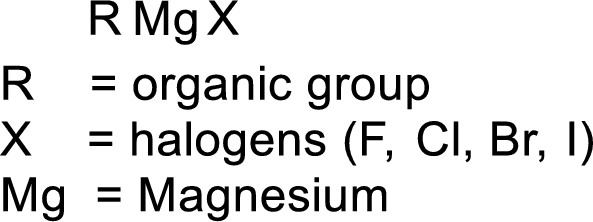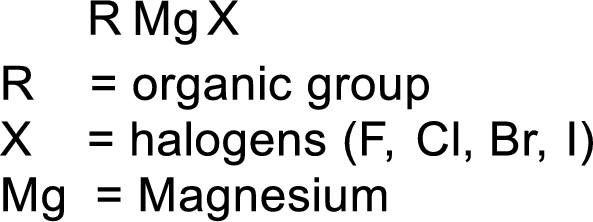
Concept explainers
(a)
Interpretation:
The product formed by the reaction between ethanal and the Grignard reagent of bromobenzene after a final reaction with water has to be given.
Concept Introduction:
Grignard reagent:
The reagent formed by the interaction of magnesium with organic halide in presence of ether is known as Grignard reagent. They are used to change the carbon skeleton of a starting carbonyl compound.

(b)
Interpretation:
The product formed by the reaction between 2-butanone and the Grignard reagent of 2-bromopropane after a final reaction with water has to be given.
Concept Introduction:
Grignard reagent:
The reagent formed by the interaction of magnesium with organic halide in presence of ether is known as Grignard reagent. They are used to change the carbon skeleton of a starting carbonyl compound.

(c)
Interpretation:
There are often two combinations of Grignard reagent and carbonyl compound that will give the same product. Another pair of reactants has to be chosen to give the product formed in part (a).
Concept Introduction:
Grignard reagent:
The reagent formed by the interaction of magnesium with organic halide in presence of ether is known as Grignard reagent. They are used to change the carbon skeleton of a starting carbonyl compound.

(d)
Interpretation:
The carbonyl compound that reacts with the Grignard reagent to yield a product with the
Concept Introduction:
Grignard reagent:
The reagent formed by the interaction of magnesium with organic halide in presence of ether is known as Grignard reagent. They are used to change the carbon skeleton of a starting carbonyl compound.

(e)
Interpretation:
The Grignard reagent and carbonyl compound used to prepare 2-methyl-2-butanol has to be given.
Concept Introduction:
Grignard reagent:
The reagent formed by the interaction of magnesium with organic halide in presence of ether is known as Grignard reagent. They are used to change the carbon skeleton of a starting carbonyl compound.

Want to see the full answer?
Check out a sample textbook solution
Chapter 15 Solutions
Chemistry: The Molecular Nature of Matter and Change
 ChemistryChemistryISBN:9781305957404Author:Steven S. Zumdahl, Susan A. Zumdahl, Donald J. DeCostePublisher:Cengage Learning
ChemistryChemistryISBN:9781305957404Author:Steven S. Zumdahl, Susan A. Zumdahl, Donald J. DeCostePublisher:Cengage Learning ChemistryChemistryISBN:9781259911156Author:Raymond Chang Dr., Jason Overby ProfessorPublisher:McGraw-Hill Education
ChemistryChemistryISBN:9781259911156Author:Raymond Chang Dr., Jason Overby ProfessorPublisher:McGraw-Hill Education Principles of Instrumental AnalysisChemistryISBN:9781305577213Author:Douglas A. Skoog, F. James Holler, Stanley R. CrouchPublisher:Cengage Learning
Principles of Instrumental AnalysisChemistryISBN:9781305577213Author:Douglas A. Skoog, F. James Holler, Stanley R. CrouchPublisher:Cengage Learning Organic ChemistryChemistryISBN:9780078021558Author:Janice Gorzynski Smith Dr.Publisher:McGraw-Hill Education
Organic ChemistryChemistryISBN:9780078021558Author:Janice Gorzynski Smith Dr.Publisher:McGraw-Hill Education Chemistry: Principles and ReactionsChemistryISBN:9781305079373Author:William L. Masterton, Cecile N. HurleyPublisher:Cengage Learning
Chemistry: Principles and ReactionsChemistryISBN:9781305079373Author:William L. Masterton, Cecile N. HurleyPublisher:Cengage Learning Elementary Principles of Chemical Processes, Bind...ChemistryISBN:9781118431221Author:Richard M. Felder, Ronald W. Rousseau, Lisa G. BullardPublisher:WILEY
Elementary Principles of Chemical Processes, Bind...ChemistryISBN:9781118431221Author:Richard M. Felder, Ronald W. Rousseau, Lisa G. BullardPublisher:WILEY





